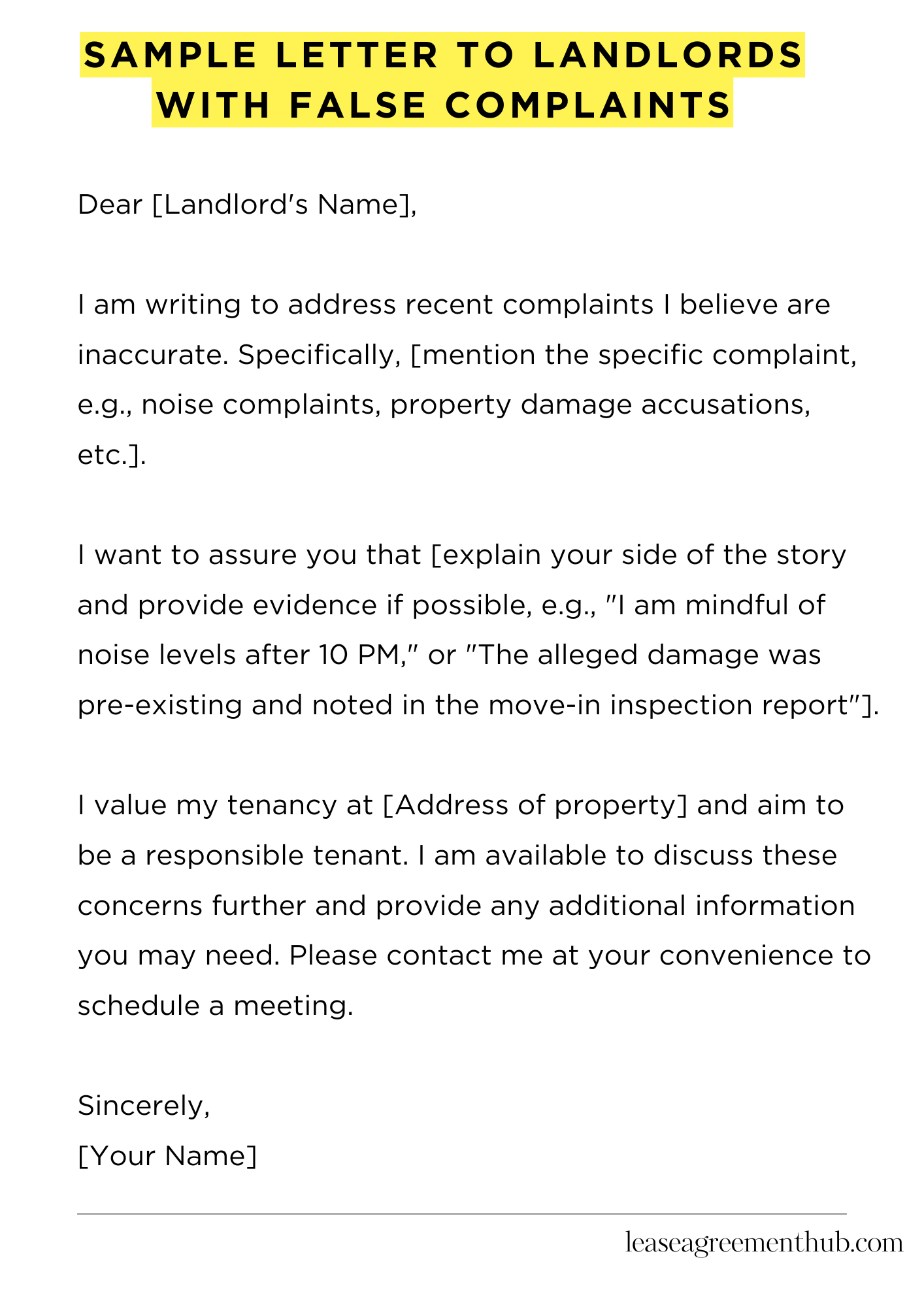A “Sample Letter To Landlords With False Complaints” is a written response. It addresses untrue accusations from your landlord. You might need this if your landlord is making things up. Maybe they’re claiming you damaged the property. Or perhaps they say you’re too noisy. This letter helps you set the record straight.
Dealing with false claims is stressful. Writing a strong response can be tough. That’s why we’re here to help.
We’ve got you covered. This article provides letter samples. Use these templates to craft your own response. Adapt them to fit your specific situation. Let’s get started and clear your name!
Sample Letter To Landlords With False Complaints
[Your Name]
[Your Address]
[Your Phone Number]
[Your Email Address]
[Date]
[Landlord’s Name]
[Landlord’s Address]
Subject: Regarding False Complaints
Dear [Landlord’s Name],
I am writing to address recent complaints I believe are inaccurate. Specifically, [mention the specific complaint, e.g., noise complaints, property damage accusations, etc.].
I want to assure you that [explain your side of the story and provide evidence if possible, e.g., “I am mindful of noise levels after 10 PM,” or “The alleged damage was pre-existing and noted in the move-in inspection report”].
I value my tenancy at [Address of property] and aim to be a responsible tenant. I am available to discuss these concerns further and provide any additional information you may need. Please contact me at your convenience to schedule a meeting.
Sincerely,
[Your Name]

How to Write Letter To Landlords With False Complaints
Subject Line: Clarity is Key
The subject line is your initial gambit. It should be concise and unequivocally state the letter’s purpose. Avoid ambiguity. A vague subject line risks being overlooked.
- Be direct: “Response to Complaint Regarding [Issue] on [Date]”
- Maintain professionalism: Avoid accusatory language.
- Include relevant details: Apartment number, if applicable.
Salutation: Setting the Tone
Even when addressing unwarranted allegations, civility is paramount. A respectful salutation lays the groundwork for a cogent response. Don’t exacerbate the situation with curtness.
- Formal: “Dear Mr./Ms./Mx. [Landlord’s Last Name],”
- If unsure of name: “Dear Landlord/Property Manager,”
- Avoid informal greetings: “Hi” or “Hello” are inappropriate.
Introduction: A Measured Rebuttal
Acknowledge receipt of the complaint and then immediately and succinctly state your position. Be forthright without being belligerent. This is your chance to frame the narrative.
- Acknowledge the complaint: “I am writing in response to your correspondence dated [Date] concerning [Issue].”
- State your position: “I respectfully disagree with the assertions made in your letter.”
- Briefly outline your reasoning: “The following information will elucidate why the complaint is unfounded.”
Body Paragraph 1: Deconstructing the Allegation
R systematically dismantle each point in the complaint. Provide concrete evidence, dates, and witnesses (if applicable) to support your counter-arguments. Precision is your ally.
- Address each allegation individually: “Regarding the claim of [Allegation 1],…”
- Provide evidence or counter-evidence: “This is factually incorrect. On [Date], [Action] occurred, demonstrating…”
- Refer to documentation: “As evidenced by [Document, e.g., photos, receipts] attached,…”
Body Paragraph 2: Context and Extenuating Circumstances
If warranted, provide context or extenuating circumstances that mitigate or nullify the landlord’s claims. However, avoid excessive verbosity. Focus on relevance.
- Explain any contributing factors: “While [Situation] did occur, it was a direct result of [Cause, e.g., plumbing issue, faulty appliance]…”
- Emphasize lack of negligence: “I took immediate action by [Action taken, e.g., reporting the issue, mitigating damage]…”
- Maintain a factual, unemotional tone.
Body Paragraph 3: Asserting Your Rights (If Necessary)
If the landlord’s complaint violates the lease agreement or tenant rights, politely but firmly assert your position. Reference specific clauses or legal provisions.
- Reference the lease agreement: “According to clause [Clause Number] of our lease agreement, [Explanation]…”
- Cite relevant tenant laws: “Under [State/Local] law regarding [Issue], it is stipulated that…”
- Avoid threats: Instead, focus on upholding your rights.
Closing: A Measured Resolution
Conclude with a professional closing that reiterates your position and suggests a path forward. Aim for resolution, not escalation. An amicable conclusion is always preferable.
- Reiterate your stance: “For the aforementioned reasons, I maintain that the complaint is without merit.”
- Suggest a resolution: “I am open to discussing this matter further to reach an amicable resolution.”
- Professional closing: “Sincerely,” or “Respectfully,” followed by your name and contact information.
Frequently Asked Questions: Responding to False Complaints
Navigating false complaints from landlords requires a strategic and well-documented approach. This FAQ addresses common concerns and provides guidance on effectively communicating your position.
What should I include in a response letter to my landlord?
Your letter should clearly state that you dispute the claims, provide factual evidence contradicting the allegations, and reference your lease agreement where relevant.
How should I deliver the response letter?
Send the letter via certified mail with return receipt requested to ensure proof of delivery and receipt by the landlord.
Should I seek legal advice before responding?
Consulting with an attorney is recommended, especially if the false complaints are part of an eviction attempt or involve significant financial implications.
What if my landlord ignores my response?
Document all communication attempts and consider further legal action, such as filing a complaint with a local housing authority or pursuing a lawsuit.
What kind of evidence is helpful to gather?
Gather dated photographs, videos, witness statements, receipts, and any other documentation that supports your position and refutes the landlord’s claims.
Related: